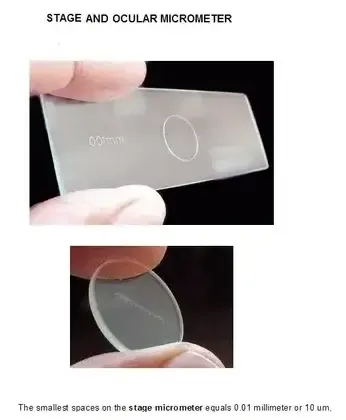Aim:
Experiment to measure the size of microscopic objects under microscope
Purpose:
The purpose of micrometry is to measure the dimensions (length, breadth, diameter and thickness) of microscopic objects (microorganisms, pollen grains, etc.) under microscope.
Materials Required:
Ocular micrometer, stage micrometer, slide, microscope, microbe/pollen grain.
Principle:
Measurement of the dimensions of microorganisms is done under microscope with the help of two micro-scales called ‘micrometers’. Both the micrometers have microscopic graduations etched on their surfaces. One of them, the ‘ocular micrometer’ is a circular glass disc, which fits into the circular shelf inside the eyepiece. It has arbitrary graduations etched on its surface. However, the distance between the etched graduations is constant for a particular ocular micrometer. The other micrometer, called ‘stage micrometer’, is a special glass slide, which is clipped to the stage of the microscope. It has standard graduations etched on its surface, which are 10 µ apart.
Calibration:
Graduations on the ocular micrometer are calibrated against the standard graduations on the stage micrometer. Calibration is required, because the distance between ocular graduations varies depending on the objective being used, which determines the size of the field.
For calibration, both the micrometer etchings are superimposed by rotating the eyepiece. The number of ocular divisions (O.D.) coinciding with the number of stage divisions (S.D.) is found out. From this, the calibration factor for one ocular division (O.D.) is calculated as follows:
If 10 O.D. coincide with 2 S.D., then
10 O.D. = 2 S.D. = 2 x 10 µ = 20 µ (Since 1 S.D. = 10 µ)
01 O.D. = 20/10 µ = 2 µ
Thus, the distance between two adjacent ocular etchings is 2 µ (i.e. calibration factor is 2 µ).
Measurement:
After calibration, the stage micrometer is removed and the microbe/pollen grain, whose dimensions are to be measured, is placed on the stage on a slide and focused. Now, the number of ocular
divisions occupied by the microorganism is counted. Then, by multiplying this number of divisions with the calibration factor, the size of the microbe is determined as follows. If the microbe/pollen grain occupies 6 O.D. in length, then length of microbe = 6 × calibration factor = i.e. 6 x 2 = 12 µ.
Procedure:
1. The eyepiece is removed from the microscope, and its top lid is unscrewed. The lid is removed. Carefully, the eye lens (Figure 5.15) is removed. The ocular micrometer (a circular etched glass piece, which slips into the eye piece) is placed carefully into the eyepiece. The eye lens is placed back, and the top lid is screwed to its original condition. The eyepiece is placed back in the microscope.
2. The stage micrometer is clipped to the stage and the etchings centered by moving the mechanical stage.
3. The low power objective is taken to position.
4. The eyepiece is rotated till the etchings on both the micrometers superimpose.
5. The required objective is taken to position. The required objective is that, using which the whole microorganism can be viewed and it covers the microscopic field to the maximum possible extent.
6. With the required objective in position (for oil-immersion objective, a drop of oil is put on the stage micrometer) the mechanical stage is moved, so that a line on the stage micrometer coincides with a line on the ocular micrometer. Then, another line is searched on the ocular micrometer, which coincides with another line on the stage micrometer. The number of divisions between the coinciding lines is counted for both the micrometers.
7. The calibration factor for the objective used is calculated.
8. In a similar way, calibration factors are calculated for the other objectives.
9. The stage micrometre is removed.
10. The slide containing the microbe to be observed is placed on the stage and focused.
11. The number of ocular divisions covered by the microbe is counted by viewing through the eyepiece.
12. The size of the microorganism/pollen grain is determined by multiplying the number of ocular divisions covered by the microbe with the calibration factor.






